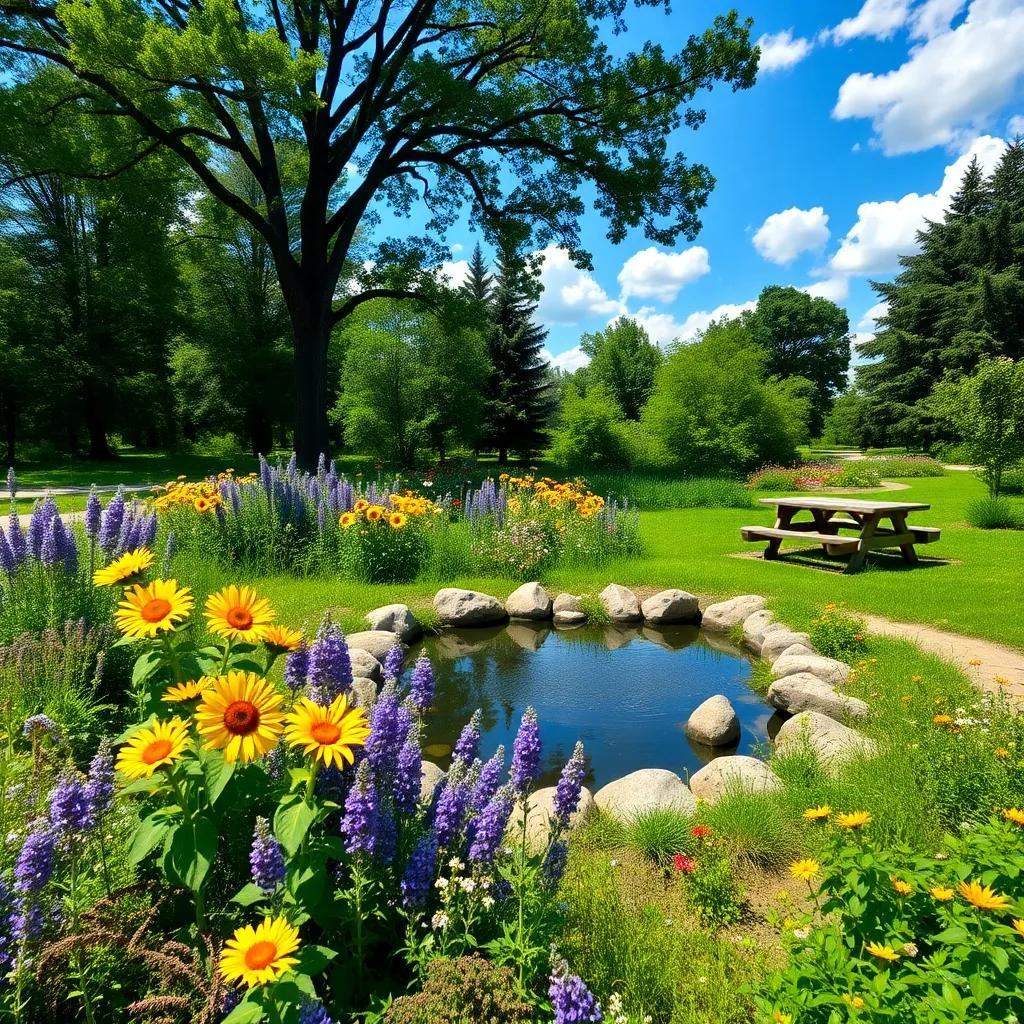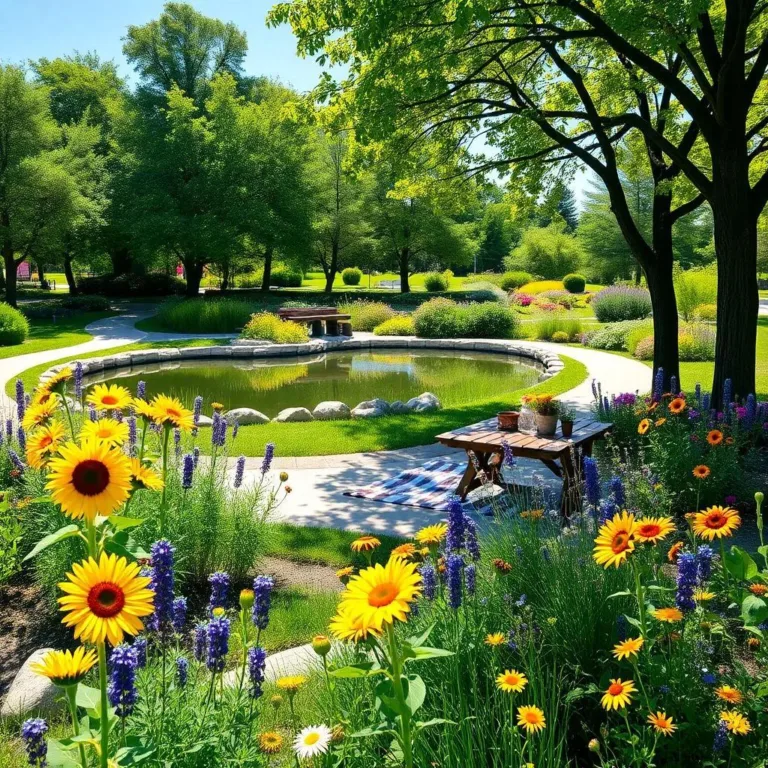Have you ever stepped into a park and felt a wave of calm wash over you? Green spaces are not just pretty places; they play a vital role in making our lives happier and healthier! In this article, I’ll share how these lush havens benefit the environment, what makes them sustainable, and how we can all get involved in keeping our green spaces thriving. Let’s dig in!
Benefits of Green Spaces for the Environment and Society
Green spaces offer a treasure trove of benefits that uplift both the environment and our communities! Let’s explore some of the amazing perks that come with these leafy havens.
- Improved Air Quality: One of the coolest things about green spaces is how they act like nature’s air purifiers. Trees and plants absorb harmful air pollutants while releasing fresh oxygen. Just think about how nice it is to take a deep breath in a park!
- Temperature Regulation: Ever felt a welcome breeze under a tree on a hot summer day? Green spaces provide shade and help cool down areas, making our neighborhoods more comfortable. This is especially important in urban areas where heat can really crank up.
- Biodiversity Boost: Green spaces are home to many plants and animals. They create habitats for various species, from chirping birds to buzzing bees. By protecting these spaces, we help preserve our planet’s rich biodiversity.
- Social Cohesion: Parks and gardens are fantastic gathering spots! They bring people together, encouraging friendships and community bonding. Imagine a sunny day with families, friends, or even new acquaintances having fun—it’s what community is all about!
- Mental Health Enhancements: Spending time in nature can work wonders for our mental well-being. Studies show that green spaces reduce stress and anxiety. So, if you ever feel overwhelmed, a stroll through the park might just be the remedy you need!
So, there you have it! Green spaces not only make our surroundings prettier, but they also play a role in improving our lives and the planet. Isn’t it amazing how something as simple as a park can impact our everyday experiences?
Key Features: What Defines Sustainable Green Spaces?
Sustainable green spaces are like the superheroes of our neighborhoods! They’re designed to thrive while keeping the environment in mind. Let’s break down some key features that make these spaces sustainable and beneficial for all!
- Native Plants: Sustainable green spaces often use native plants. These plants are great because they require less water and care. Plus, they support the local wildlife! Imagine butterflies flitting around and birds singing happily—it creates a vibrant ecosystem.
- Water Management: Effective water management strategies, like rain gardens and permeable surfaces, help soak up rainwater. This is a win-win! It reduces runoff and keeps our water sources cleaner.
- Community Involvement: A sustainable green space isn’t just for plants and animals; it’s also about us! Involving the community in planning and maintaining these areas fosters love and care. When people feel connected, they take pride in their parks and gardens!
- Multi-Functional Design: These spaces serve multiple purposes. They can be gardens, playgrounds, or areas for exercise and relaxation. This multifunctionality means more people can enjoy them in various ways! Think yoga classes on the grass or picnics under the trees—so fun!
- Regular Maintenance: A little TLC goes a long way! Sustainable green spaces need regular maintenance to stay healthy and vibrant. It can involve everything from planting new flowers to cleaning up litter. And who knows, you might make new friends while volunteering!
By keeping these features in mind, we can create green spaces that are not only sustainable but also bring joy to our lives. Isn’t that what we all want? A little more green and a lot more happiness!

Challenges to Maintaining Sustainable Green Spaces
Maintaining sustainable green spaces is not always a walk in the park! They face various challenges that can make it tricky to keep them lush and lively. Let’s explore some of the common hurdles we encounter.
- Urban Development: As cities grow, green areas can disappear! With new housing and infrastructure, green spaces often get sacrificed for buildings and roads. This makes it essential to incorporate green space planning into urban development right from the start. It’s like trying to bake a cake without enough ingredients—something’s going to be missing!
- Limited Land Availability: Land can be scarce, especially in busy cities. Finding new spots for parks or gardens can feel like trying to squeeze toothpaste back into the tube! To tackle this, we can get creative by using vertical gardens, rooftop gardens, or pocket parks—small green spaces tucked between buildings. They can offer nature’s benefits without taking up much space!
- Insufficient Maintenance: Green spaces need regular care to stay healthy and thriving. Unfortunately, many parks suffer from neglect and litter. This can lead to overgrown plants and areas that just don’t look inviting. Engaging local communities in maintenance can help keep these spaces in tip-top shape! After all, when people care for something, it shows!
- Climate Change: With rising temperatures and changing weather patterns, green spaces may struggle to survive. This can affect plant growth and the overall health of these areas. To tackle this issue, we can implement sustainable landscaping practices that promote resilience. Planting native species is a fantastic idea since they’re more likely to thrive in our local climates!
By understanding and addressing these challenges, we can work together to maintain vibrant and sustainable green spaces that benefit everyone!
Strategies for Enhancing Urban Green Space Sustainability
Now that we’ve explored the challenges, let’s chat about some strategies to make urban green spaces even better! With a dash of creativity and a sprinkle of community spirit, we can enhance these precious areas.
- Integrated Planning: Planning is key! Urban planners should integrate green spaces into development plans from the very beginning. This means thinking ahead and designing neighborhoods that include parks, gardens, and natural areas. It’s like putting together a jigsaw puzzle—every piece has to fit just right!
- Native Planting: When designing green spaces, let’s stick with plants that are native to the area. These plants require less water and care, making them more sustainable! Plus, they attract local wildlife, creating a buzz of activity and color. It’s a win-win! Imagine a garden filled with butterflies flitting about—what a sight!
- Community Involvement: Getting the community involved is vital! Hosting clean-up days, tree planting events, or workshops can engage locals and foster a sense of ownership. When people feel connected to their green spaces, they are more likely to take care of them. Plus, it’s a great way to meet your neighbors!
- Sustainable Maintenance Practices: Regular maintenance is essential, but it doesn’t always have to be costly. Adopting sustainable maintenance practices can save money while keeping green spaces beautiful. This can include using organic gardening methods, composting, and using rainwater for irrigation. Green thumbs up!
- Education and Awareness: Spreading the word about the importance of green spaces can motivate others to get involved! Hosting workshops or informational sessions about gardening, conservation, or wildlife can raise awareness. Who knew learning could be so fun?
By implementing these strategies, we can enhance our urban green spaces, making them more sustainable and enjoyable for everyone!
Community Engagement in Green Space Development
The community plays a huge role in the success of green spaces! When people come together, we can create wonderful places that everyone in the neighborhood can enjoy. Let’s dive into how we can engage the community in green space development!
- Involvement in Planning: When planning new green spaces, it’s essential to involve the community from the start. Gathering input from locals about what they want can help create parks that truly meet their needs. This could be anything from playgrounds, picnic areas, or walking paths that connect to other neighborhoods!
- Volunteering Opportunities: Organizing volunteer events in green spaces encourages people to get their hands dirty while improving their environment. Whether it’s planting trees, weeding, or cleaning up litter, people love to roll up their sleeves! It’s also a great chance to make new friends while working toward a common goal.
- Celebration Events: Hosting community events in parks, like outdoor movie nights, farmers’ markets, or seasonal festivals, can bring people together and celebrate nature! These events create a sense of belonging and remind everyone of the beauty around them. Plus, they can be super fun! Who doesn’t love a good picnic?
- Education Programs: Offering educational programs about gardening, wildlife, and sustainability encourages people to connect with nature. Schools, local organizations, or community groups can host workshops where everyone can learn about ecology while having fun.
- Feedback and Improvement: After a green space is developed, keeping the lines of communication open is essential. Gathering feedback from the community allows for continuous improvement. If something isn’t working, locals can suggest changes to make it better!
By actively involving the community in green space development, we can create thriving, enjoyable spaces that foster connection, joy, and a love for nature! Let’s work together to make our neighborhoods greener and more vibrant!

